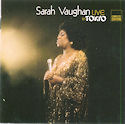 Sarah Vaughan Live in Japan:
Sarah Vaughan Live in Japan:
The Complete Edition
Sarah Vaughan
Jazz Lips JL758
Sarah Lois Vaughan (1924-1990) branded a singular singing style that will never go out of style. Whether the song was traditional or modern, dramatic or humorous, at the core of each performance was an exquisitely controlled, astonishing voice that spanned over four octaves. For her operatic instrument she was called “The Divine One” whereas “Sassy” was a moniker for her personality before, during and especially after the gig. “Live in Japan” is a worthy re-issue which finds the Divine One in heavenly form, backed by her swinging trio: Carl Schroeder on piano, John Gianelli on bass and Jimmy Cobb at the drums. Pushing fifty, she was in supreme voice and apparently a jovial mood to boot. At the Sun Plaza Hall in Tokyo in September of ’73, the audience ate it all up and craved more. The Nearness of You is a rare 7-minute treat with Vaughan accompanying herself on the piano, while Summertime is treated like a true aria and the last note of Over the Rainbow inhabits 17 seconds. Similarly, the ballad renditions of ‘Round Midnight, I Remember You and My Funny Valentine show off Sassy’s masterful approach to vibrato. Musically very savvy, Vaughan was a smart improviser: There is No Greater Love begins with three separate scat duets with drums, bass and piano; memorable wordless choruses make up I’ll Remember April, All of Me and The Blues which showcase the rhythm section. The requested encore Bye Bye Blackbird is a surprisingly joyous, swingin’ blast. In 2006, the Library of Congress honoured this album by adding it to the United States National Recording Registry. Formerly a costly ebay item, the complete edition retails for $40 including good liner notes, an interview, photographs and a bonus track. Alternately, one can find this concert on iTunes, issued under Mainstream Records.
Ori Dagan
Extended Play
Sampling Soundscapes
by Ken Waxman
Creating musical sounds without instruments has become widespread ever since the availability of first the portable tape recorder and then the lap top computer. Melding oscillations created with software plus amplifications of so-called found sounds, often re-mixed, these soundscapes are notable for their subtle mixture of foreground and background.
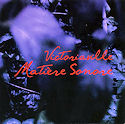 Canadians – especially Québécois – have been particularly proficient in this sort of composing, as these CDs demonstrate. So have Europeans, which is why Habitat (Creative Sources CS 105 CD), by the German dis.playce duo provides an interesting contrast to the Canadians’ work. For comparison, both that CD and Victoriaville Matière Sonore (Victo cd 0113) created by eight sound designers – Francisco López, Louis Dufort, Chantal Dumas, A_Dontigny, Steve Heimbecker, Mathieu Lévesque, Hélène Prévost and Tomas Phillips – are audio portraits of specific places.
Canadians – especially Québécois – have been particularly proficient in this sort of composing, as these CDs demonstrate. So have Europeans, which is why Habitat (Creative Sources CS 105 CD), by the German dis.playce duo provides an interesting contrast to the Canadians’ work. For comparison, both that CD and Victoriaville Matière Sonore (Victo cd 0113) created by eight sound designers – Francisco López, Louis Dufort, Chantal Dumas, A_Dontigny, Steve Heimbecker, Mathieu Lévesque, Hélène Prévost and Tomas Phillips – are audio portraits of specific places.
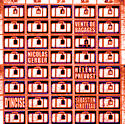 Geographical reflection is also involved in Bill Gilonis’ and Chantale Laplante’s Zürich-Bamberg (AD HOC 22) and Éric Normand’s Vente de Bagages - Volume Un (Tour de Bras TDB 3001), but these collaborations expose another electronic music variant. Montrealer Laplante and Londoner Gilonis, then living in cities which give the disc its title, collaborate on sound collages by tweaking individual audio files sent to one another. Rimouski-based Normand follows the collaborative pattern, although the found sounds he alters originated in different European cities and in Montreal.
Geographical reflection is also involved in Bill Gilonis’ and Chantale Laplante’s Zürich-Bamberg (AD HOC 22) and Éric Normand’s Vente de Bagages - Volume Un (Tour de Bras TDB 3001), but these collaborations expose another electronic music variant. Montrealer Laplante and Londoner Gilonis, then living in cities which give the disc its title, collaborate on sound collages by tweaking individual audio files sent to one another. Rimouski-based Normand follows the collaborative pattern, although the found sounds he alters originated in different European cities and in Montreal.
Hélène Prévost, one of Normand’s audio pen-pals, is the only person represented on two CDs; and that’s appropriate. One of the doyennes of auditory creation, her contributions fit individual situations in which they are placed. Matière Sonore’s VSM for instance, suggest a story line with muffled male and female voices, a ticking clock and sirens intermingling with rumbling hisses, blurry rustles and reverberated intonation traceable back to computer programming.
On Vente de Bagages however (www.tourdebras.com), the bed track of static intonation and hiss from her side is reconfigured with audio effects and stutters created and equalized by the noises produced with a microphone held in Normand’s mouth. This overt physicality and evident sonic building blocks is what distinguishes Normand’s sound postcards from the other discs. On another track, his circular cackles, cries and cock-a-doodle-doos expand the quicksilver squeaks and tremolo flutters produced by the brass mouthpiece and valves manipulation of Toulouse-resident Sébastien Cirotteau.
Organized by Spanish sound artist Francisco López to create an audio portrait of Victoriaville, Quebec, Matière Sonore’s soundscape is more anonymous and selfless (www.victo.qc.ca). Sequentially panning across the aural landscape of the city which hosts an annual experimental music festival, private and public spaces are exposed and transformed. Particular starting points are mixed electronically and are simultaneously linked and divorced from sources. Louis Dufort’s materio _***, for example, features snatches of gull caws and dog yelps, followed by slithery organ-like riffs and otherworldly shrills, and preceded by ring modulator echoes, plus swelling blurry thumps. Meanwhile Chantal Dumas tells her story on s/t w/t 2 with intonation from spectral railway-crossing peals, thunder claps and people shouting, plus radio dial twisting that locates and loses snatches of recorded music. She ends with door slamming sounds.
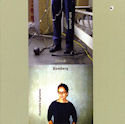 Coincidentally Zürich-Bamberg (www.chantalelaplante.com) begins with the sounds of a door opening, follow by quivering piano strings. Completed by a couple of tracks of solo Laplante that alternate prolonged silences with fortissimo, stop-time abrasions and echoes, the CD’s key manipulated collages are These 12 Minutes and the title track. Undulating, intermittent oral gasps top an undercurrent of foot steps on the former. Eventually the textures are redirected together as backwards-running beats. Slivers of English, French and German phrases stud the title track as these disembodied voices philosophize, hector and promote. Also audible are intercut disconnected waves of melodic, hard-rock and Arab music that occasionally reveal simple guitar licks or drum patterns. Surmounting this are further processed sounds which originate in falling rain, whistling birds, draining sinks and idling engines. The result is both descriptive and disconcerting.
Coincidentally Zürich-Bamberg (www.chantalelaplante.com) begins with the sounds of a door opening, follow by quivering piano strings. Completed by a couple of tracks of solo Laplante that alternate prolonged silences with fortissimo, stop-time abrasions and echoes, the CD’s key manipulated collages are These 12 Minutes and the title track. Undulating, intermittent oral gasps top an undercurrent of foot steps on the former. Eventually the textures are redirected together as backwards-running beats. Slivers of English, French and German phrases stud the title track as these disembodied voices philosophize, hector and promote. Also audible are intercut disconnected waves of melodic, hard-rock and Arab music that occasionally reveal simple guitar licks or drum patterns. Surmounting this are further processed sounds which originate in falling rain, whistling birds, draining sinks and idling engines. The result is both descriptive and disconcerting.
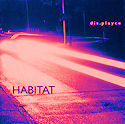 So too is Habitat (www.creativesourcresrec.com). Created by German electronics manipulators Maximilian Marcoll and Hannes Galette Seidl to be site-specific, the tracks rely on recordings made in Frankfurt or Karlsruhe of the scratches, yowls, squeaks and cries that reflect those cities’ passing streetscapes. Panning across the sonic panorama, found sounds are captured at close range or at a distance, sometimes drawing away from the mikes as definition is established. As electronics distort the actualities with soothing watery squishes, flanged woodpecker-like clatter or rumbling cheeps and buzzes, the process becomes nearly hypnotic in its regularity.
So too is Habitat (www.creativesourcresrec.com). Created by German electronics manipulators Maximilian Marcoll and Hannes Galette Seidl to be site-specific, the tracks rely on recordings made in Frankfurt or Karlsruhe of the scratches, yowls, squeaks and cries that reflect those cities’ passing streetscapes. Panning across the sonic panorama, found sounds are captured at close range or at a distance, sometimes drawing away from the mikes as definition is established. As electronics distort the actualities with soothing watery squishes, flanged woodpecker-like clatter or rumbling cheeps and buzzes, the process becomes nearly hypnotic in its regularity.
Very much of its own place and style, this European CD confirms Canadians’ invention and pre-eminence in this particular version of sonic art.



